the “best” best sellers
Examining a Decade's Worth of The New York Times Best Sellers
Which Best-Selling Books Are the Best?
There’s nothing quite like the stamp of approval from The New York Times for a book. The New York Times Best Sellers seal denotes more than weekly unit sales success: A book that makes the list has also earned a high number of “diverse sales.” In other words, best sellers garner sales from a variety of sellers, as opposed to a single venue, such as an influencer’s social media account. But does this diversity of sales success translate to reader satisfaction? And which best sellers are the best reads? We wanted to find out.
Breaking down this illustrious list every which way, we asked: Do NYT Best Sellers rate well among readers? Do certain genres typically earn skyrocketing sales but not such great reviews? And how often does a book make the list only to disappear a week later? If you’ve ever wondered what The New York Times Best Sellers label really means, keep reading.
Ranking the Best Sellers
To find out which best sellers rank on top with readers, we matched data from The New York Times with customer ratings from Goodreads, the largest book review site. We then created a combined “meta score” based on the average “Review Star Rating” from Goodreads, the number of times the title appeared on The New York Times Best Sellers list, and its average rank on that list (“Best Sellers Rank”). See the top 20 of these combined-score titles in the infographic below.
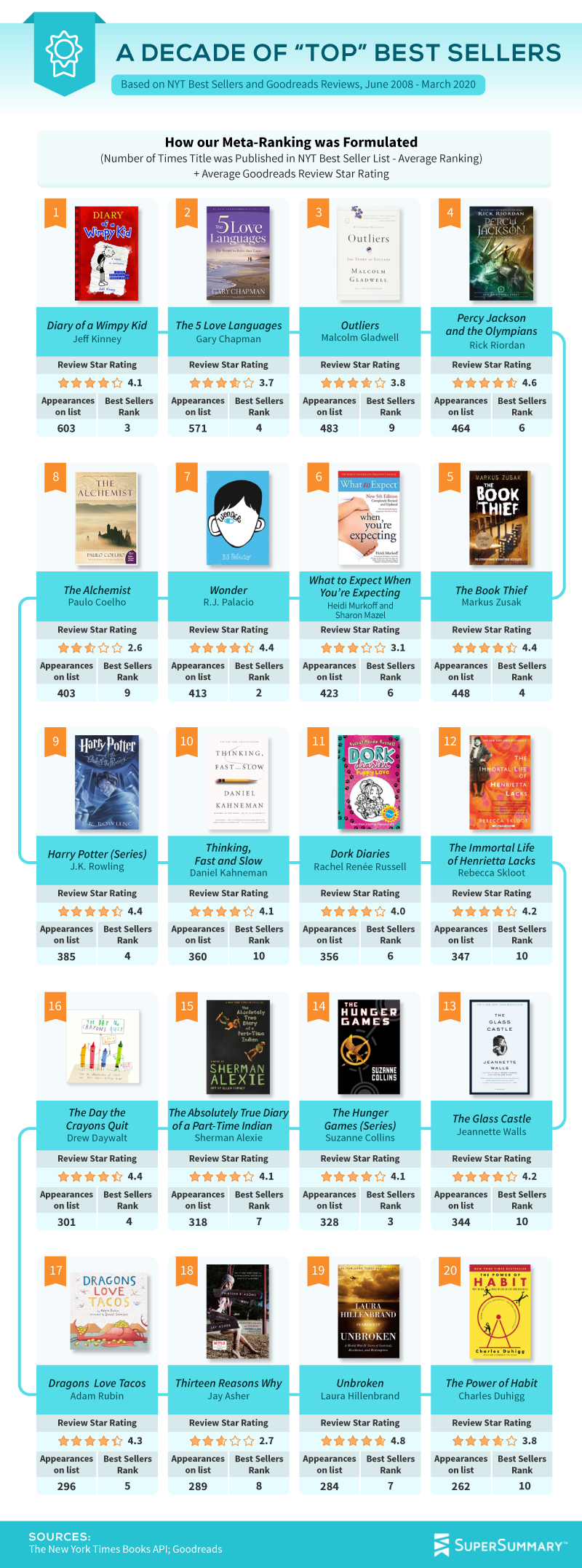
Diary of a Wimpy Kid came out on top when we combined sales success with reader ratings. Since 2008, Diary of a Wimpy Kid has landed on The New York Times Best Sellers list 603 times, earned an average star review of 4.1 from Goodreads, and had an average NYT Best Seller rank of three.
Interestingly, the majority of the 20 combined-score titles were middle grade and young adult fiction. Diary of a Wimpy Kid shared space with The Hunger Games series (328 appearances), Dork Diaries (356 appearances), and the Harry Potter series (385 appearances), among others.
Self-help books fared well, too. The 5 Love Languages, a book about improving communication in romantic relationships, appeared 571 times on The New York Times Best Sellers list and earned an average rank of two for each of its 571 appearances. What To Expect When You’re Expecting, an instructional book about pregnancy, also performed well over the decade. And The Power of Habit, a book on practicing consistency, had 262 NYT appearances and earned a perfect Best Sellers rank of 10.
Reader Ratings
For the next part of our study, we compared the average Goodreads ratings of books that made the NYT Best Sellers list over the last decade. It turns out that ratings and sales have become more aligned over the years. The average overall rating for best-selling books has increased.
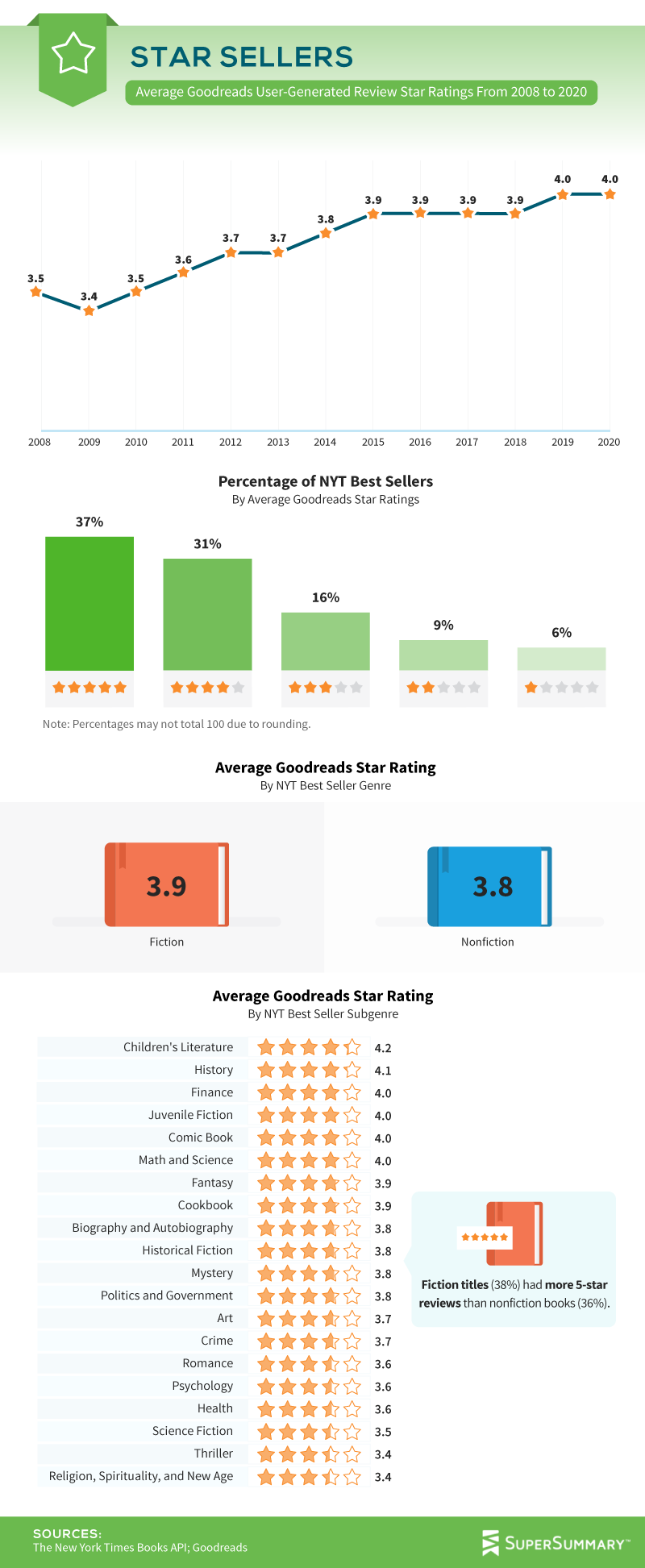
Most NYT Best Sellers had five-star reviews. Just a tiny 6% of the books on the list earned one star from readers. Fiction titles had slightly more five-star reviews (38%) than nonfiction books (36%). And children’s literature in general (typically fiction) was the top-rated genre among readers.
Fiction wasn’t always a unifier, however. Only a certain type of fiction made the grade with readers. They most often disagreed with The New York Times when it came to science fiction and thrillers, giving these books an average of 3.5 and 3.4 stars, respectively.
Best Reader-Rated Titles
Next, our study ranked individual titles from the Best Sellers list based on average Goodreads star rating. A children’s book took the top spot again, this time it was Gravity Falls: Journal 3, interactive adventure story. The children’s literature ended there, however, as more adult-oriented, nonfiction titles stole the hearts of many readers.
Many of the best-loved customer titles were often gut-wrenching tales of emotional turmoil. Titles like Unbroken, a harrowing tale of war survival, as well as Just Mercy, a nonfiction book about racism within the justice system, earned 4.8 and 4.7 stars, respectively. (The popularity of Just Mercy has apparently also translated to the screen.) Hamilton: The Revolution was also highly adult-oriented, albeit much more lighthearted.
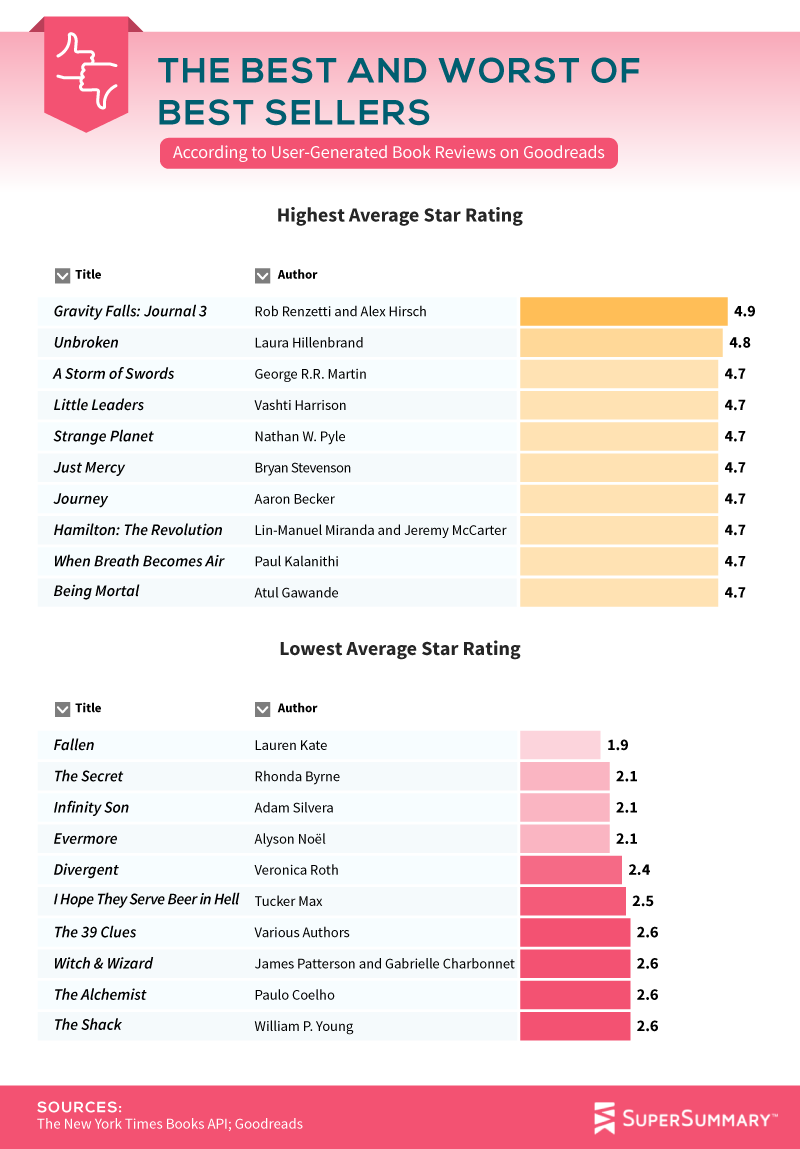
Fallen was the least-loved book on The New York Times Best Sellers list over the last decade. Readers gave this book just 1.9 stars on average. One of the harsher critics claimed there was actually no way to leave an accurate review, as the book was so bad that “it’s impossible to describe.” Another reader insisted that the book was suitable only for those who “wanted to learn how not to write.” Nevertheless, the book has sold millions of copies in more than 30 countries.
Readers seemed to dislike the less intellectual books in general: Both I Hope They Serve Beer in Hell and Divergent earned very low reviews for best sellers. While the former tells comedic and often sexually graphic tales, the latter is a lowbrow teen thriller.
Forgotten in a Week
Next, we analyzed the “one-week wonders”— those books that made The New York Times Best Sellers list for a single week and then vanished. The vast majority of books did continue on the list for longer than a week, with the average title hanging on for eight list appearances. But 37% of the 15,236 books we analyzed enjoyed exactly seven days in the spotlight, and that’s it.
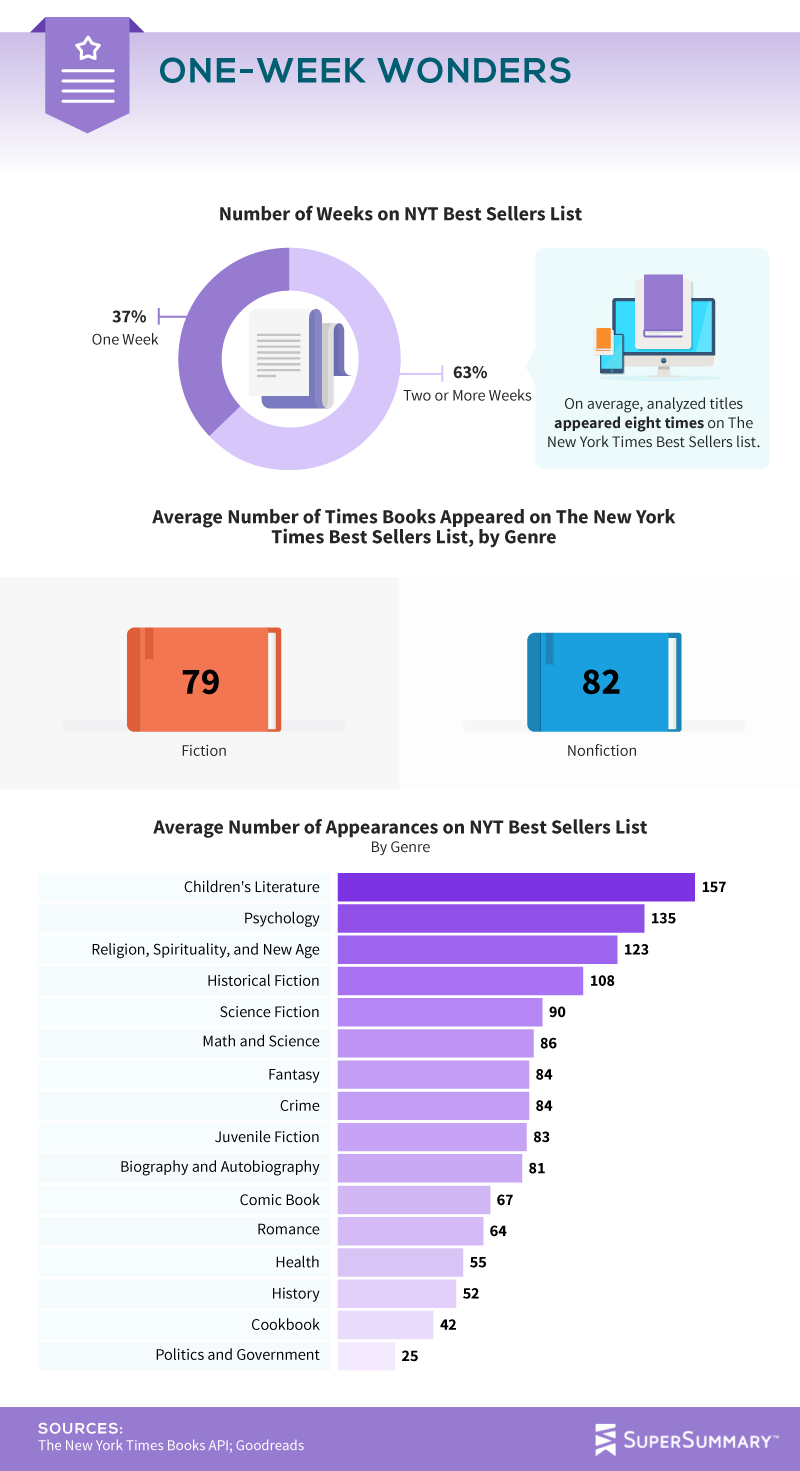
Fiction and nonfiction were again neck and neck, but this time nonfiction had a slight edge. Nonfiction books remained on the list a bit longer than fiction. Many types of fiction performed well: Children’s literature, historical fiction, and science fiction all enjoyed lengthy placements as Best Sellers. Science fiction and religion, which fans rated very poorly on Goodreads, were two of the most often seen genres on The New York Times list.
Longest Running Books
Two of the combined-score “best” best sellers were also two of the books with the longest run on The New York Times Best Sellers list. In an attempt to explain the pop-culture sensation that was The Diary of a Wimpy Kid in 2009, The New York Times wrote that the book gave a rare insight into “a child’s ethical mind,” and by using words like “jerk” and “dork” was able to convert previously frustrated or challenged readers.
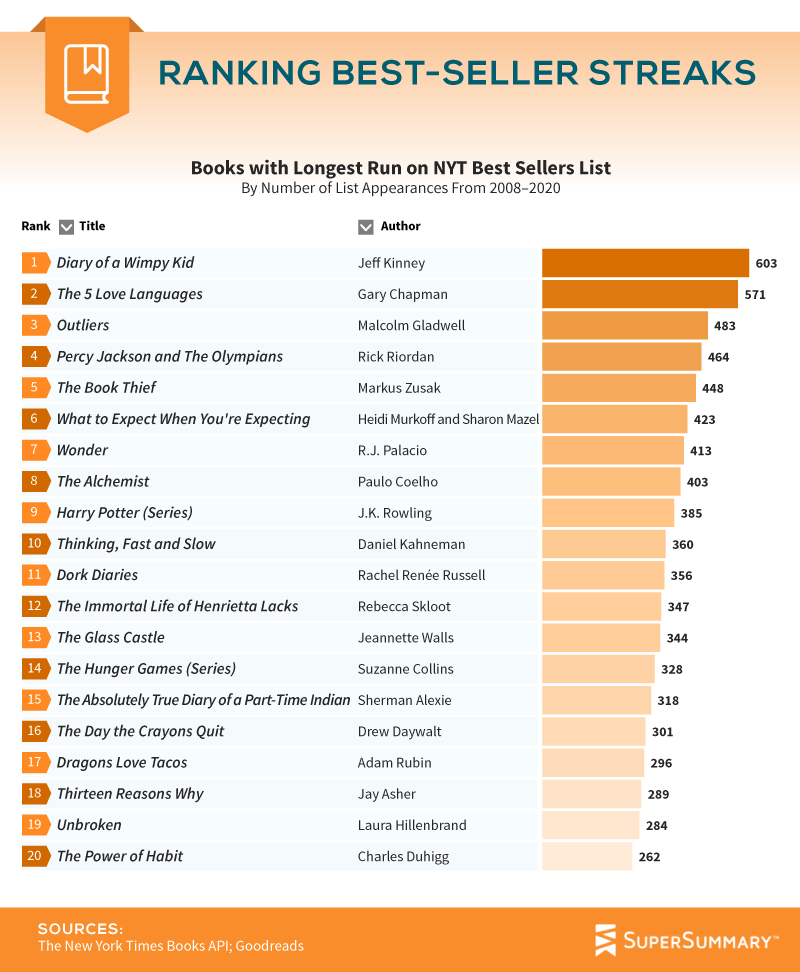
The 5 Love Languages by Gary Chapman prompted The New York Times to write a 2011 article titled “Can Gary Chapman save your marriage?” –a powerful indicator of the book’s perceived effectiveness and corresponding popularity.
Outliers by Malcolm Gladwell had the third strongest run, earning 483 placements on the Best Sellers list over the last 10 years. In this book, Gladwell examines the factors that contribute to success, a topic people trust him to speak on. Many other books of Gladwell’s have reached Best seller status as well.
The Best Reading
In the end, The New York Times Best Seller list was far more aligned with readers’ tastes than not — making the list a wonderful place to start looking for your next great book suggestion.
Once that perfect book is in your hands, make sure you get the most out of it. Take a deep dive into the meaning behind the words with SuperSummary’s literature study guides. Whether you’re working on a class assignment, preparing a lesson plan, or planning a book club discussion, SuperSummary can help you understand—and love—your next read.
Methodology
For this project, we first pulled a list of all titles on The New York Times Best Sellers list from June 22, 2008 to March 29, 2020. We then determined the top 100 titles per year based on the number of times each title was published on The New York Times Best Sellers list. We then subtracted this number by the average ranking of the title. Once we had this list, which totaled 716 unique titles, we pulled a list of the top 100 reviews from Goodreads.com. Our meta-score was formulated by calculating the number of times a title was published on The New York Times Best Sellers list. We then subtracted this by the average Best Sellers list ranking. We then added the average star rating for the top 100 reviews to create a total score. Appearances on the list may not include every title of a book series (Harry Potter, for example) due to the date range analyzed.
Fair Use Statement
The reviews you leave or the titles you share with friends could end up leading someone to their new favorite book. If you’d like to share the titles and information within this article with a friend or someone you know, you just have to be sure your purposes are noncommercial and that you link back to this page.
